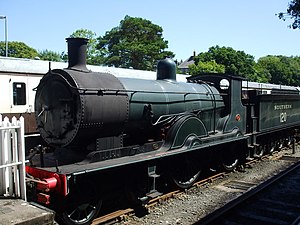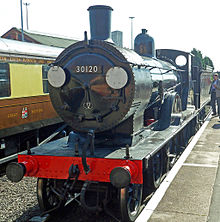LSWR T9 class
| LSWR T9 class "Greyhound"[1] | |||||||||||||||||||||||||||||||
|---|---|---|---|---|---|---|---|---|---|---|---|---|---|---|---|---|---|---|---|---|---|---|---|---|---|---|---|---|---|---|---|
 Preserved 30120 on Bodmin and Wenford railway. | |||||||||||||||||||||||||||||||
| |||||||||||||||||||||||||||||||
| |||||||||||||||||||||||||||||||
| |||||||||||||||||||||||||||||||
| |||||||||||||||||||||||||||||||
The London and South Western Railway T9 class was a class of 66 4-4-0 steam locomotive designed for express passenger work by Dugald Drummond and introduced to services on the LSWR in 1899. One example has been preserved after British Railways ownership.
Background
Intended for express passenger work in South-West England, 66 were eventually built and saw several improvements throughout their service careers. The class operated until 1963 when the last example,No 30120, was withdrawn. 30120 was preserved by the National Railway Museum, and is currently on long term loan to the Bodmin and Wenford Railway.
Construction history
The design spawned from the relative failure of Drummond's C8 Class of 1898, utilising many lessons learned from this design.[2] A larger boiler was implemented, and such confidence was placed in Drummond's design that an order of 50 locomotives was placed straight off the drawing board. Large fireboxes and Stephenson link valve gear ensured a free-steaming locomotive.[3]
Builders
Construction was shared between the LSWR's Nine Elms Locomotive Works, London and Dübs and Company of Glasgow. Twenty were built at Nine Elms and 30 by Dübs.[3] These were constructed between 1899 and 1900 and supplied with six wheel tenders. A second batch was ordered, and 15 more were constructed at Nine Elms, while a final, solitary example was constructed at Dübs and Company for the Glasgow Exhibition of 1901.[2] Detail improvements on this final batch were a wider cab and revised wheel splasher that hid the 'throw' of the connecting rod, with cross-water tubes fitted into the firebox.[3] This was an attempt to increase the heat surface area of the water, which was achieved, though at a cost in boiler complexity. This batch was also fitted with the Drummond "watercart" eight-wheel tender for longer running, whilst the previous was retrofitted with the design.[3]
Construction table
| Year | Order | Builder | Quantity | LSWR numbers | Notes |
|---|---|---|---|---|---|
| 1899 | Nine Elms | 113–122 | |||
| 1899 | Nine Elms | 280–284 | |||
| 1899 | Dübs & Co. 3746–3775 | 702–719, 721–732 | |||
| 1900 | Nine Elms | 285–289 | |||
| 1900 | Nine Elms | 300–304 | |||
| 1901 | Nine Elms | 305, 307, 310–312 | |||
| 1901 | Nine Elms | 313, 314, 336–338 | |||
| 1901 | Dübs & Co. 4038 | 773 | renumbered 733 in 1924 |
Urie's modifications
Upon Drummond's death in 1912, his successor, Robert Urie, supplied the class with superheaters, and from 1922, the entire class was so treated.[2] Their sterling performance as a class precluded any further modifications, apart from the removal of the cross-water tubes, an enlarged smokebox, addition of a stovepipe chimney, and an increase of the cylinder bore to 19 inches (480 mm). These had been completed by 1929.[3]
Livery and numbering
LSWR and Southern
Livery under the LSWR was Drummond's LSWR Passenger Sage Green, with purple-brown edging and black and white lining.[4] Under Southern Railway ownership from grouping in 1923, the locomotives were outshopped in Richard Maunsell's darker version of the LSWR Sage Green with yellow lettering on the tender, with black and white lining.
This livery was continued under Bulleid despite his experimentations with Malachite Green, though the 'Southern' lettering on the tender was changed to the 'Sunshine Yellow' style. During the Second World War, members of the class outshopped from overhaul were turned out in wartime black.
The class was haphazardly numbered by the LSWR. The Nine Elms batch was numbered 113 to 122 and 280 to 289, whilst the Glasgow batch was allocated 702 to 719 and 721 to 732. A final locomotive, 773, was constructed in Glasgow. With one exception, numbering under the Southern retained the LSWR allocations.[2]
Post-1948 (nationalisation)
Livery after Nationalisation was initially Southern livery with 'British Railways' on the tender, and an 'S' prefix on the number. The class was subsequently outshopped in BR Mixed Traffic Black with red and white lining, with the BR crest on the tender.[5]
Locomotive numbering was per BR standard practice, from 30113–30122; 30280–30289; 30300–30305;30307;30310-30314; 30336–30338; 30702–30719; and 30721-30733. Numbering was based upon the batches built with the addition of 30000 to the SR numbers. However, thirteen of the locomotives had been withdrawn by the end of 1948, and this resulted in gaps in the numerical sequence.[5]
Operational details

The T9 Class locomotives were well liked by their crews, and gained the nickname Greyhounds early in their operational career due to the good turn of speed that these locomotives were capable of on LSWR expresses. Indeed, even in old age they were still capable of speed in excess of 80mph. They proved of great use west of Salisbury where their light axle loadings and short frame lengths were better suited to the tight curves of the Southern's Western Section.[3] In 1947, 13 locomotives were converted to oil burning. This experiment ended in 1948, and all locomotives involved were withdrawn[5]
LSWR/SR 119 (BR 30119) was used by the Southern Railway and early British Railways as a Royal engine and as such was painted in malachite green livery[5]
The class remained intact throughout Southern Railway ownership 1923–1947 and 20 still remained on BR's books in 1959, being used on lighter duties in the westcountry.[6][7] All, however, had been withdrawn by 1963 upon the advent of the BR Modernisation Plan.[5]
Preservation


One engine, LSWR/SR 120 (BR 30120), was saved for preservation by the National Railway Museum. Withdrawn from Exmouth Junction shed, Exeter in 1961 it remained in capital stock. In March 1962 it was outshopped from Eastleigh Works following a heavy casual repair and returned to service in LSWR green working ordinary services as well as special trains. It was finally withdrawn from capital stock in July 1963 but continued to work special trains until October of that year.
Following lengthy periods in store at Fratton, Stratford, Preston Park, Tyseley and York, it was again overhauled in the early 1980s on the Mid Hants Railway and returned to steam in 1983. However, because of the steep gradients on the Mid Hants,it moved to the Swanage Railway in 1991 and remained there until its boiler certificate expired in 1993. It then moved to the Bluebell Railway, where it remained as a static exhibit on public display and under cover, until 1 February 2008. It then moved to the Bodmin and Wenford Railway, and was returned to steam in August 2010 following a heavy overhaul including repairs to the cylinder block at the Flour Mill Workshop in the Forest of Dean. It has been repainted in early British Railways lined black colour scheme and is regularly used on passenger trains at Bodmin. It is now once again on loan to the Swanage Railway.
References
- Bradley, D. L. (1986). LSWR Locomotives: The Drummond Classes. Didcot, Oxon: Wild Swan Publications. ISBN 0-906867-42-8.
- Cooper, Peter (1983). Greyhound 120. Urie S15 Preservation Group.
- Gerard, Malcolm; Hamilton, J. A. B. (1981) [1967]. Trains to Nowhere. London: Georg Allen & Unwin. ISBN 0-04-385084-7.
- Grayer, Jeffery (2006). "Gone to the dogs?". Backtrack. 20: 142–147.
- Herring, Peter (2000). Classic British Steam Locomotives. London: Abbeydale Press. ISBN 1-86147-057-6.
- Longworth, Hugh (2005). British Railway Steam Locomotives: 1948–1968. Oxford Publishing Company. ISBN 0-86093-593-0.
- Siviour, Gerald (2005). "The twilight years of the Greyhounds in Wessex". Steam Days: 84–95.
- Swift, Peter (2006). Maunsell 4-6-0 King Arthur Class. Locomotives in Detail, volume 4. Hinckley: Ian Allan Publishing. ISBN 0-7110-3086-3.
Further reading
- Bradley, D. L. (1977). The Drummond Greyhounds of the LSWR. Newton Abbot: David & Charles. ISBN 0-7153-7329-3.
- Crosse, J. A. (1997). "A look at the Drummond T9 class". Backtrack. 11: 392–394.
